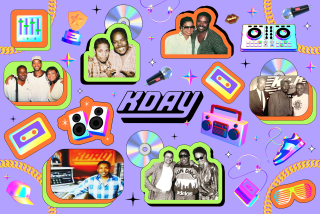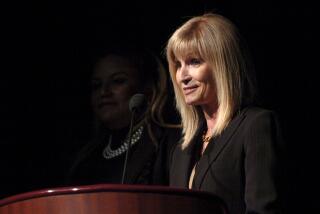Little Radio Station Goes Hog Wild as Internet Brings World to Its Pen
- Share via
WATSONVILLE, Calif. — An esoteric little radio station with no play lists and the weakest signal in its market is topping online radio charts as people around the world discover its irreverent delights.
“Their programming is very, very tasty, and I have such wonderful connections with the DJ’s and the listeners so I feel a little bit like a part of the family,” said Sandy Georges, who listens through her computer in Paris.
KPIG, 107-oink-5, has long been an important part of the Santa Cruz and Monterey communities, featuring an eclectic mix of music--folk, country, rock, Hawaiian, Cajun, local artists and more. Listeners along California’s Central Coast have loyally supported the station since its roots as KFAT in the 1970s in Gilroy. It’s not possible to drive more than a mile in the area without spotting one of its “Praise the Lard” bumper stickers.
But being popular in Santa Cruz County--even wildly popular like KPIG--never meant much in the world of radio. Despite being praised by Rolling Stone magazine, KPIG hovered around the middle of the 7,000 radio stations in the country when it came to the number of listeners.
Then the Internet opened up the world.
In 1995, when the notion of streaming radio broadcasts over the World Wide Web was just a possibility, disc jockey “Wild” Bill Goldsmith decided to give it a try. With $5,000 of his own money and no training, he launched KPIG onto the Information Highway, pioneering a new medium.
His endeavor paid off. Online listeners now surpass locals.
During a typical week, the station will have 50,000 “terrestrial” listeners out of about 500,000 in the survey area. Online, about 60,000 people tune in through their computers, according to ratings for late last year from the Arbitron Co. in New York. KPIG says that’s now up to 90,000.
“KPIG has a huge Internet presence,” said Joan FitzGerald, Arbitron’s director of marketing. “They’ve been leaders in Internet radio for a long time because they’ve got a really hot format.”
FitzGerald said online users who are streaming media--downloading music and video--are intelligent listeners and consumers who want something different.
“They’re going to the Internet to get it,” she said.
There are about 4,000 radio stations on the Internet. The leaders tend to be news talk stations or, like KPIG, alternative.
Among other top stations is the Fan, at https:www.texasrebelradio.com, featuring songs by Texans and about Texas. KCDU-FM, at https://www.cd93.com, is “modern adult contemporary.”
Powering the technology behind https://www.kpig.com as well as six of the other top-10 Internet radio stations is Chicago-based Magnitude Network.
Leaning back in his chair and stretching his feet onto a desk, Goldsmith laughs at the high-tech talk.
“I’m really good at picking stuff up as I go,” he said.
But he’s not surprised at their online success.
“Corporate radio is so formulaic, so boring, so lame,” he said. “There’s no substance or soul to them. People all over the world are just not getting what they want from their local radio, which is why we’re becoming their local radio.”
To visit KPIG, drive south from San Francisco about 150 miles to the farming community of Watsonville. Turn up the driveway behind the Chinese restaurant and go up the stairs of what looks like a former motel in the back.
That’s where KPIG’s 12 employees work, among at least three bickering dogs, thousands of CDs and record albums and managers who have been together for about 25 years.
Even though the station’s online listeners have begun to outnumber local listeners, the managers don’t plan to change their format. That means Internet listeners from Maine to India get the morning surf report, traffic warnings about injured mountain lions on the highway, and twice-daily news from “pundit-at-large” Travus T. Hipp, who pontificates to “the Pigsters” each morning about politics, truth, justice and modern life.
“Radio is fantasy, a soundtrack for people’s lives,” said program and music director Laura Ellen Hopper. “The Santa Cruz weather and traffic let listeners visualize what it’s like to be in this beautiful area.”
KPIG’s independence was threatened three years ago when it was bought--along with another station--by New Wave Broadcasting for $5.2 million.
Corporate officials tried to change the format to classic rock. But DJs led an on-air “revolution” and listeners bombarded New Wave’s managers with outraged commentary.
“Finally the suits decided to leave us alone,” Hopper said. “Now we play their lousy ads for 10 minutes an hour, and they let us do what we do for the other 50 minutes.”
More to Read
The biggest entertainment stories
Get our big stories about Hollywood, film, television, music, arts, culture and more right in your inbox as soon as they publish.
You may occasionally receive promotional content from the Los Angeles Times.










